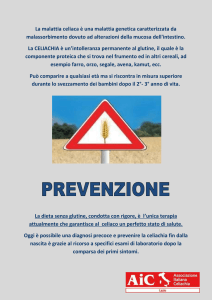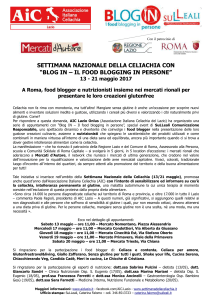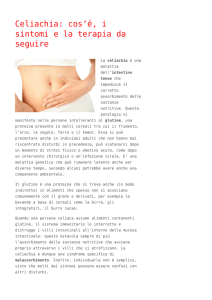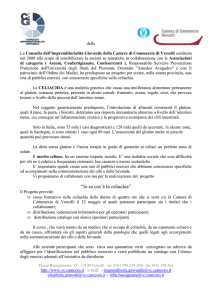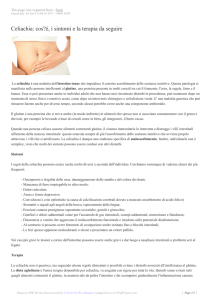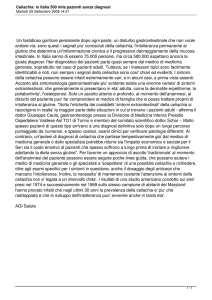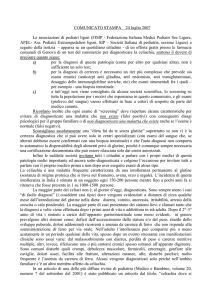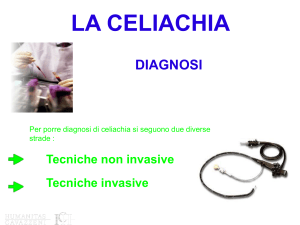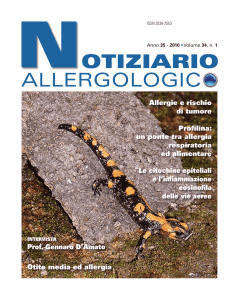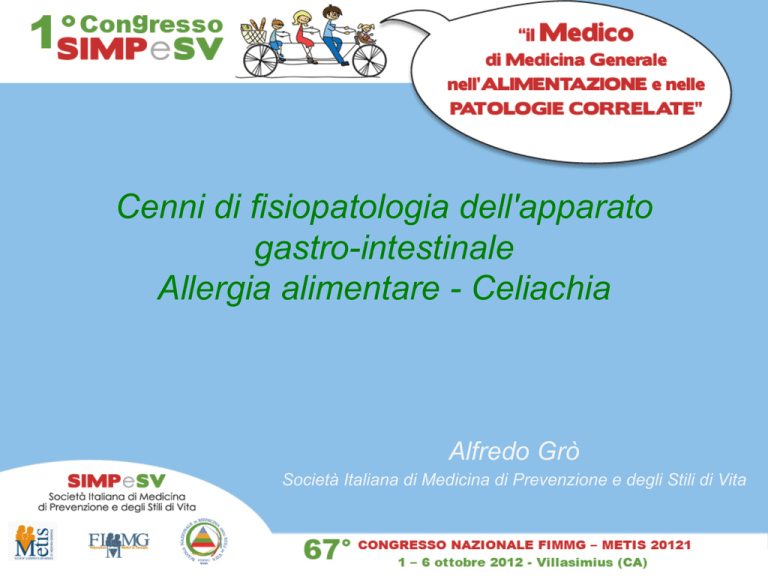
Cenni di fisiopatologia dell'apparato
gastro-intestinale
Allergia alimentare - Celiachia
Alfredo Grò
Società Italiana di Medicina di Prevenzione e degli Stili di Vita
OBIETTIVI E PROGRAMMA APPROFONDIRE LA CONOSCENZA DI MALATTIE DI RILEVANZA CLINICA ATTRAVERSO IL RICORDO DI NOZIONI DI FISIOPATOLOGIA DELL'APPARATO GASTRO-­‐INTESTINALE COINVOLTO ANATOMIA E FUNZIONE DEL DUODENO, DIGIUNO, ILEO E DELL'ENTEROCITA ALLERGIE ALIMENTARI: MALATTIA CELIACA REAZIONI IMMUNOLOGICHE, CENNI STORICI ALIMENTI COINVOLTI PATOGENESI TEST DI DIAGNOSI CLINICA TRATTAMENTO DIAGNOSI E TERAPIA INTESTINO TENUE
DUODENO, DIGIUNO, ILEO PLACCHE DEL PEYER (FOLLICOLI LINFATICI) CRIPTE DI LIEBERKUHN (PROTEASI, DISACCARIDASI, LIPASI) PATOLOGIE ASSOCIATE ULCERA DUODENALE SPRUE TROPICALE ENTEROPATIA DA GLUTINE ALLERGIE ALIMENTARI CELLULE ENTEROCROMAFFINI (ISTAMINA) MORBO DI CROHN GHIANDOLE DEL BRUNNER (MUCO) FARMACI CITOTOSSICI ENTEROCHINASI ILEO PARALITICO SECRETINA ILEO MECCANICO PANCREOZIMINA Le allergie alimentari
ALIMENTI SINTOMATOLOGIA LATTE (LATTALBUMINE, LATTOGLOBULINE) VOMITO UOVO (ALBUME) DIARREA MUCOSA O MUCO-­‐EMATICA GRANO STIPSI SOIA REFLUSSO GASTRO-­‐ESOFAGEO RISO DISTENSIONE ADDOMINALE PESCE SINTOMI EXTRAINTESTINALI (ASMA, RINITE, ECZEMA) POMODORO ARACHIDI CLASSIFICAZIONE DELLE REAZIONI
AVVERSE AL CIBO
Reazioni avverse al cibo
Intolleranze alimentari
Dipendenti
dalle
caratteristiche
dell’alimento
Dipendenti
dalle
caratteristiche
dell’ospite
• Contaminanti
tossici
• Sostanze
con attività
• Difetti
enzimatici
• Malattie
metaboliche
• Fattori
psicopatologic
i
farmacologica
Allergie alimentari
Non IgE
mediate
IgE mediate
Miste
CLASSIFICAZIONE DELLE REAZIONI IMMUNOLOGICHE TIPO 1: IPERSENSIBILITA' IMMEDIATA O ANAFILASSI – IGE MEDIATA L'ALLERGENE SI LEGA AD ANTICORPI PREFORMATI SULLA SUPERFICIE CELLULARE DI MASTOCITI O BASOFILI E LIBERA MEDIATORI CHIMICI. E' CAUSA DI ASMA, RINITE, SHOCK ANAFILATTICO, ALLERGIA ALIMENTARE TIPO 2: CITOTOSSICHE – IgG, IgM L'ALLERGENE SI LEGA ALLA CELLULA, IN GENERE LINFOCITI, PROVOCANDO L'ATTIVAZIONE DEL COMPLEMENTO E L'APOPTOSI CELLULARE E' RESPONSABILE DI MALATTIE EMOLITICHE, CELIACHIA TIPO 3: DA IMMUNOCOMPLESSI – IgG,IgM,IgA IL SISTEMA ANTIGENE-­‐ANTICORPO SI RAGGRUPPA IN STRUTTURE COMPLESSE CHE SONO RESPONSABILI DI LESIONI TISSUTALI O DELL'ENDOTELIO VASALE PROVOCA NEFRITE, VASCULOPATIE TIPO 4: DA IPERSENSIBILITA' RITARDATA -­‐ COINVOLGE I LINFOCITI T ED E' COINVOLTA NELLA DERMATITE DA CONTATTO E NELLA INTRADERMOREAZIONE ALLA TUBERCOLINA (MANTOUX) Le allergie alimentari
TEST ATTENDIBILI SCIENTIFICAMENTE SKIN PRICK TEST (test cutanei intradermici con l'allergene da testare) RAST ( determinazione delle IgE specifiche) ATOPY PATCH TEST (o ceroQo reazione, TEST DI PROVOCAZIONE ORALE TEST IN CORSO DI VALIDAZIONE O NON ATTENDIBILI DEGRANULAZIONE DEI BASOFILI RILASCIO DI ISTAMINA DAI BASOFILI ALCAT TEST (anRgen leukocytes cellular anRbody test) BIORISONANZA, KINESIOLOGIA, TEST ELETTRODERMICI, ANALISI DEL CAPELLO PERCORSO DIAGNOSTICO NEL BAMBINO CON SOSPETTA ALLERGIA
ALIMENTARE
Anamnesi
• Familiare: uno o più familiari affetti da patologie allergiche e in particolare da
allergia alimentare;
• Personale: data di inizio e descrizione dei sintomi, relazione temporale con
l’assunzione dell’alimento.
Valutazione
clinica
• Caratteristiche del quadro clinico compatibili con una diagnosi di allergia
alimentare;
• Attenta valutazione di possibili patologie in diagnosi differenziale: esclusione
di difetti anatomici, patologie metaboliche, infettive o infiammatorie.
Test
allergologici
• Skin Prick Test;
• Dosaggio dei livelli sierici di IgE specifiche anti-alimento;
• Atopy Patch Test.
Dieta di
eliminazione
Verifica
diagnostica
Scrupolosa valutazione di una risposta clinica a una dieta di eliminazione
rigorosa.
Attenta valutazione di una risposta clinica al test di provocazione orale
(all’aperto o al cieco).
Hautarzt. 2010 Nov;61(11):961-6.
l
[Inappropriate test methods in allergy].
[Article in German]
Kleine-Tebbe J, Herold DA.
l
Source
Allergie- u. Asthma-Zentrum Westend, Praxis Hanf, Herold & Kleine-Tebbe, Spandauer Damm 130, Haus 9, 14050, Berlin. [email protected]
l
Abstract
Inappropriate test methods are increasingly utilized to diagnose allergy. They fall into two categories: I. Tests with obscure theoretical basis,
missing validity and lacking reproducibility, such as bioresonance, electroacupuncture, applied kinesiology and the ALCAT-test. These methods
lack both the technical and clinical validation needed to justify their use. II. Tests with real data, but misleading interpretation: Detection of
IgG or IgG4-antibodies or lymphocyte proliferation tests to foods do not allow to separate healthy from diseased subjects, neither in
case of food intolerance, allergy or other diagnoses. The absence of diagnostic specificity induces many false positive findings in healthy
subjects. As a result unjustified diets might limit quality of life and lead to malnutrition. Proliferation of lymphocytes in response to foods
can show elevated rates in patients with allergies. These values do not allow individual diagnosis of hypersensitivity due to their broad
variation. Successful internet marketing, infiltration of academic programs and superficial reporting by the media promote the popularity of
unqualified diagnostic tests; also in allergy. Therefore, critical observation and quick analysis of and clear comments to unqualified methods by
the scientific medical societies are more important than ever
Recenti Prog Med. 2002 May;93(5):327-34.
l
[Alternative tests in the diagnosis of food allergies].
[Article in Italian]
Senna G, Gani F, Leo G, Schiappoli M.
l
Source
Unità Operativa di Allergologia, Ospedale Civile Maggiore, Verona. [email protected]
l
Abstract
In the last years an increase of allergic diseases has been observed whose prevalence is about 20-30% in general population of western countries.
However there is a risk of an over diagnosis of allergic diseases as many different diseases (migraine, chronic urticaria, chronic inflammatory
bowel diseases, chronic-fatigue syndrome etc.) are considered due to food allergy or intolerance. In many patients the diagnosis is based on the
results of alternative diagnostic tests such as the cytotoxic test, the provocation/neutralization sublingual or subcutaneous test, the heart-ear reflex
test, the kinesiology, the biorisonance, the electro-acupuncture, and the hair analysis, or on immunological tests (immunocomplex or specific food
IgG). We reviewed the scientific evidences of these tests (specificity, sensibility, rationale, reproducibility). According to most studies none of
them had to be recommended as useful for the diagnosis of food allergy or intolerance. Physicians should alert patients about the risk of
an indiscriminate use of these test in the diagnosis of food allergy. In fact the use of an incorrect diet could be dangerous, particularly in
childhood, as recently shown
Minerva Pediatr. 1995 May;47(5):159-63.
l
[Food allergy: comparison of diagnostic techniques].
[Article in Italian]
Mancini S, Fierimonte V, Iacovoni R, Spaini A, Viarani P, Pichi A.
l
Source
III Divisione Pediatria, Ospedale Bambino Gesù, Roma.
l
Abstract
Fourteen children affected with allergic disease, from 8 months to 7-years-old, were studied; three children had Bronchial asthma, one child
Bronchial asthma and rhinitis, one child recurrent laryngospasm, six children atopic dermatitis, two children diarrhoea, one abdominal pain. In
all patients cow's milk and egg were the most common offending foods. Total IgE serum level, IgE serum specific, Prick test and ALCAT
test (the test predicts food which would produce a problem) were investigated. A comparison among the different laboratory methods for
food allergy diagnosis was analyzed
La celiachia (koiliakos= ventre, cavità)
PRIMA DESCRIZIONE: ARETEO DI CAPPADOCIA (1° SECOLO A.C.)
WILLELM KAREL DICKE (1945/50) ASSOCIO' LA MALATTIA AL GLUTINE
L'A.I.C. (associazione italiana celiachia) STIMA LA FREQUENZA TRA 1/80 e 1/200
CON 380.000 MALATI DI CUI L'85% E' ASINTOMATICO O NON DIAGNOSTICATO;
DEL 15% DEI SINTOMATICI PIU' DELLA META' NON AVREBBE A TUTT'OGGI
ANCORA UNA DIAGNOSI CERTA
CAUSA DELLA MALATTIA LA GLIADINA, UNA FRAZIONE PROTEICA INSOLUBILE
DEL FRUMENTO, NEGLI ALTRI CEREALI (orzo, avena, miglio, sorgo, camut)
QUESTA FRAZIONE E' LA GLUTAMMINA
celiachia (2)
Presenza di antigeni di istocompatibilità tipo II, normalmente presenti sulla superficie dei
linfociti T per innescare la difesa anticorpale verso i virus.
Talvolta tali antigeni si legano a sostanze estranee (glutine) o a cellule dell'ospite
(autoimmunità)
Nella celiachia sono coinvolti i DQ2 e DQ8, entrambi presenti in oltre il 90% dei malati
La malattia può insorgere in ogni epoca della vita, nei primi anni assume spesso una
sintomatologia tipica (forme maggiori), nelle decadi successive invece le forme
atipiche sono le più frequenti (forme minori).
E' oggetto di studio se la malattia comunque inizi in età infantile o venga innescata
da fattori favorenti anche in età adulta
celiachia (3)
Maggiore:
Malattie associate
Steatorrea
Malassorbimento
Diabete tipo 1
Perdita di peso
Tiroidite
Sindrome di Sjiogren
Sindrome di Down
Dermatite erpetiforme
Minore
Anemia
Ipoplasia smalto
Afte buccali
Osteoporosi
Infertilità
Sindromi psichiatriche (schizofrenia,
autismo, epilessia)
SANO CELIACO celiachia (4)
Complicanze
Linfoma intestinale a cellule T
Celiachia refrattaria
Digiuno-ileite ulcerativa
celiachia (5)
Test diagnostici
Anticorpi antigliadina – AGA -(IgA, IgG)
Anticorpi antiendomisio (EMA) – IgA
Anticorpi antitransglutaminasi tissutale (tTGA)
Endoscopia ed esame bioptico della mucosa duodenale:
Marsh 1 – infiltrazione linfocitaria
Marsh 2 – iperplasia delle cripte
Marsh 3 – atrofia dei villi
celiachia (6)
Terapia
Dieta di eliminazione per tutta la vita (glutine inferiore a 20 p.p.milione)
Marcatori di aderenza alla dietoterapia: negativizzazione entro 1 anno degli
anticorpi antitransglutaminasi ed antiendomisio
Per informazioni: ASSOCIAZIONE ITALIANA CELIACHIA (A.I.S.)
www.celiachia,it

